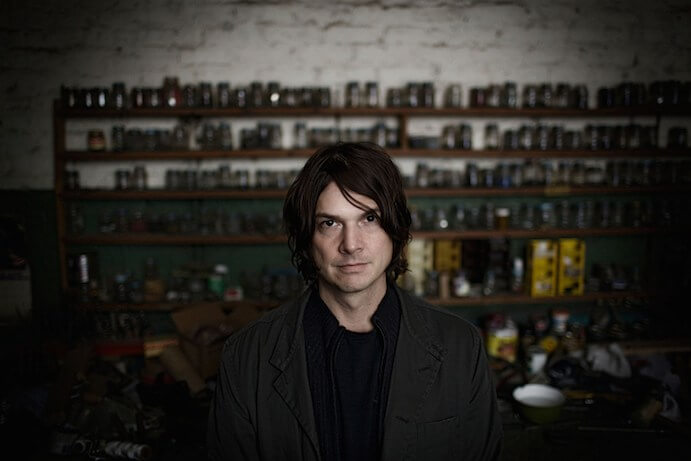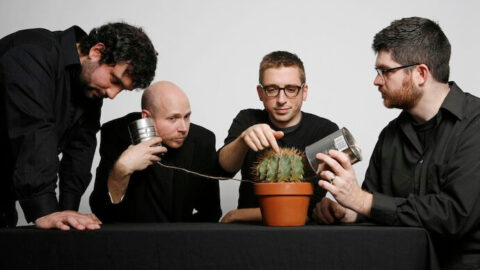An excited audience waited in anticipation for the 7:30 pm downbeat by Sō Percussion in Meany Theater, located in Seattle, Washington, on January 31, 2016. Hosting a live stream of the concert, Second Inversion’s Maggie Stapleton introduced the ensemble to a diverse audience. Sō Percussion took the stage amongst an impressive array of traditional and not-so-traditional percussive instruments.
Immediately, the pulsations of Steve Reich’s Mallet Quartet began to appease the audience, growing from one marimba to another. A constant layer of density and pulsations created by the two marimbas laid the harmonic groundwork for the two vibraphones’ hocketed melodic material. The performers gave the harmonic structure of Fast a vigorous and fluid vivacity that never became stale, despite the repetition of pitch and rhythmic material. As the vibraphones passed melodic material back and forth with an unimaginable, seamless technical prowess, every subtle change or permutation of rhythm became extraordinarily impactful. With the second movement, Slow, Sō Percussion highlighted a pleasantly-unusual side of Reich’s compositions. Simple but unpredictable unison rhythms were surprisingly spaced to allow for various lengths of resonances, exposing the unique colors and timbres of the instruments. This engaging surprise set up the last movement, Fast, which brings back a similar feel and material as the first.
“I can hear you all screaming in your living rooms at home,” Jason Treuting said to those listening on the live stream. Taking a break to talk to the audience and introduce the next piece, Drum Kit Quartet #51, Treuting introduced composer Glenn Kotche as “…the drummer for Wilco, and a dork.” Despite the title, this is the only Drum Kit Quartet piece by Kotche that is not actually for a drum set quartet. Sō Percussion lined up on either side of the two marimbas, gently beginning with individual tones played with space between. A simple melodic contour slowly emerged as the unison rhythm pulled apart into a free, unhindered cloud following the same contour. A subtle tape track colored the melody, adding flavor to the work without overwhelming the original melodic material. The piece was further colored as the ensemble changed instruments to include drum set, rattle, and wind wand. The erratic but repetitive pulse of the piece is highlighted by the drum set’s rock like beat, creating a much desired scaffolding to which the previous melodic material was able to be heard in a different light. Sō Percussion allowed their passion and control to come through in a work that could easily become stale in a half-hearted performance– however, with Sō Percussion presenting the work, there was not a moment in which the work lost its luster.

“If we were a string quartet, this would be our Haydn,” Treuting said as he introduced John Cage’s Third Construction. Written while Cage was living in Seattle, Sō Percussion was happy to be performing the work in the city it was composed. Tin cans, wood blocks, congas, shakers, toms, and other alien-like instruments littered the section of the stage. With a bang, the piece broke into a noisy, raucous groove. It was immediately evident that Sō Percussion enjoys performing this work, each performer moving with the music and interacting by making eye contact as if they were telling jokes with one another. The energy was raw and untethered, coupled with an unbelievable technical prowess. The structure of the work creates a striking ebb and flow of densities, timbres, and rhythmic complexities and kept the audience entranced. Cue the interrupting conch shell and unleash a wave of noise and energy that the entire audience had a physical, visceral response to. What an incredible performance right before intermission.
“Once upon a time… the world was round.”
In lieu of an intermission, Sō Percussion performed Story from John Cage’s Living Room Music. “This is for all of you in your living room listening on tiny speakers,” Treuting announced. The interplay of spoken word and syllabic sounds created a beat box-like character, an enjoyable change of pace before the finale. To round off the concert, Sō Percussion performed Music for Wood & Strings by Bryce Dessner. Dessner, a Grammy award-winning guitarist with the band The National, is an incredible multitalented musician. Treuting introduced Dessner by saying, “He plays shows in stadiums, and he’s also a dork.”
I’m sensing a theme…

Music for Wood & Strings features an instrument invented by Dessner called a Chord Stick, described as part electric guitar, part hammer dulcimer. Sō Percussion mastered this instrument, creating incredible, lush colors and timbres through various playing techniques. The repetitive harmonic structure of the work sustained intrigue through showing the combinations of colors created by layering different playing techniques. In an incredible display of precision and virtuosity, Sō Percussion created an amazing stereophonic experience, passing around broken timbral material rapidly. The sound encompassing the audience grew as the complex polyrhythmic grooves pushed the piece to an intense and sudden ending.
An immediate roar of applause erupted before the ensemble could take a breath as the audience jumped to their feet. After two or three curtain calls, Sō Percussion took the stage for an encore of Steve Reich’s Clapping Music. Sō Percussion performed an astounding concert, creating a unique experience for all listeners. With a high level of talent and artistry, as well as an obvious love and enjoyment of the music being played, Sō Percussion gave an unreplicable performance the audience won’t be quick to forget.
I assume some are still screaming in their living rooms.
























